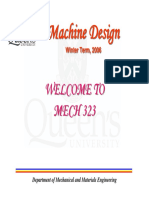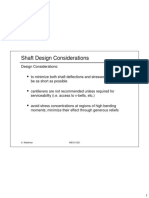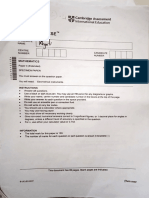Accelerating On A Ramp
Accelerating On A Ramp
Uploaded by
Gaurav AgarwalCopyright:
Available Formats
Accelerating On A Ramp
Accelerating On A Ramp
Uploaded by
Gaurav AgarwalOriginal Description:
Original Title
Copyright
Available Formats
Share this document
Did you find this document useful?
Is this content inappropriate?
Copyright:
Available Formats
Accelerating On A Ramp
Accelerating On A Ramp
Uploaded by
Gaurav AgarwalCopyright:
Available Formats
Accelerating on a Ramp
Apparatus
wind up toy car, ramp
Action
The students allow the car to roll down the ramp (without winding it up). They draw a free body
diagram showing the forces acting on the trolley.
They then wind the car up so that it can accelerate up the ramp for at least a short distance. They
should draw a free body diagram showing the forces on the car as it climbs the slope.
The Physics
The forces acting on the toy car as it rolls down are gravity, friction and the normal force. The
component of gravity along the direction of the slope is greater than any frictional forces and gives an
acceleration down the ramp.
When the toy car is wound up and set to climb the ramp its wheels exert a force on the ground.
The ground exerts an equal and opposite force, due to friction, on the cars wheels which push the car. As
long as the coefficient of friction is great enough that slipping does not occur, and the force on the wheels
is greater than the component of gravity down the hill, the car will accelerate.
accelerating up:
accelerating down:
N = mgcos
Ffriction due to ground
N = mgcos
Ffriction
mgsin
+ Ffriction due to air
mgsin
mgscos
mgscos
Accompanying sheet
Accelerating on a Ramp
Place the car at the top of the ramp and release it.
What happens? Why?
Draw a free body diagram of the car.
How does a car accelerate up a hill?
Draw a free body diagram showing the forces acting to accelerate a car up a hill.
A car with some initial speed reaches a downwards slope
and the driver allows the car to roll down the hill.
Will the car necessarily accelerate?
You might also like
- Exercise 7: Climbing AimDocument7 pagesExercise 7: Climbing Aims ramanNo ratings yet
- Standardiso Rops 3471Document2 pagesStandardiso Rops 3471Gaurav AgarwalNo ratings yet
- Prabhu, Punit - Data Analytics With Excel (2021)Document152 pagesPrabhu, Punit - Data Analytics With Excel (2021)paula100% (2)
- Lect 18Document18 pagesLect 18Gaurav AgarwalNo ratings yet
- D1403 D1703 V1903 V2203 PDFDocument38 pagesD1403 D1703 V1903 V2203 PDFGaurav AgarwalNo ratings yet
- The Physics Behind CarsDocument11 pagesThe Physics Behind CarsAws EljarahNo ratings yet
- The Physics of RacingDocument5 pagesThe Physics of RacingDHAARSHANAH A/P DHANABALAN MoeNo ratings yet
- The Physics of Racing Part 1: Weight TransferDocument35 pagesThe Physics of Racing Part 1: Weight TransferOğuzhan SaçıNo ratings yet
- Vehicle OverturnDocument31 pagesVehicle OverturnNaishadh J Desai AnD'sNo ratings yet
- The Physics of RacingDocument5 pagesThe Physics of RacingDHAARSHANAH A/P DHANABALAN MoeNo ratings yet
- Physics of RacingDocument151 pagesPhysics of RacingJonathan BryantNo ratings yet
- Lecture 9 Vehicle DynamicsDocument31 pagesLecture 9 Vehicle Dynamicsmohamedabohassan19991No ratings yet
- Rolling FrictionDocument11 pagesRolling FrictionsukujeNo ratings yet
- Traction and Lateral ForceDocument16 pagesTraction and Lateral Forcemu_rajesh3415No ratings yet
- Conservacion de La EnergiaDocument4 pagesConservacion de La EnergiaDaniel GonzalesNo ratings yet
- Circular Motion: Motion Along A Curved PathDocument14 pagesCircular Motion: Motion Along A Curved PathAnurag MalikNo ratings yet
- Vehicle DynamicsDocument29 pagesVehicle DynamicshaftommmmNo ratings yet
- Module 2Document33 pagesModule 2HimanshuNo ratings yet
- Problem 7.1: No Elements SelectedDocument42 pagesProblem 7.1: No Elements SelectedDFGNo ratings yet
- Chapter 1Document29 pagesChapter 1Arkew BogaleNo ratings yet
- Lesson 5Document12 pagesLesson 5Ryan KoNo ratings yet
- Resistance To MotionDocument2 pagesResistance To MotionVishal SharmaNo ratings yet
- VD Chap - Road LoadsDocument41 pagesVD Chap - Road LoadsbmdbmdbmdNo ratings yet
- Application of FrictionDocument3 pagesApplication of Frictionsamarpita.banerjee06No ratings yet
- F 1 BacaanDocument7 pagesF 1 BacaanSYAIPUL ZAIHAM BIN ZULKIFLI MoeNo ratings yet
- Quiz On Newtons Law Physics Elective No AnswerDocument5 pagesQuiz On Newtons Law Physics Elective No AnswerJerimiah MirandaNo ratings yet
- Center of Gravity and Moment ArmDocument6 pagesCenter of Gravity and Moment ArmJam BabNo ratings yet
- Unit 9Document22 pagesUnit 9Taufik RhomeNo ratings yet
- Aerodynamics of VehiclesDocument1 pageAerodynamics of VehiclesRuchi SinghNo ratings yet
- RacingDocument65 pagesRacingjoao maria pmNo ratings yet
- FinalDocument10 pagesFinalapi-253250697No ratings yet
- Brian Beckam - The Physics of Car RacingDocument65 pagesBrian Beckam - The Physics of Car RacingShashi MauryaNo ratings yet
- What Is The Force That Act On Roller Coaster Car During A Roller Coaster Ride - DoDocument4 pagesWhat Is The Force That Act On Roller Coaster Car During A Roller Coaster Ride - DoJane OmberoNo ratings yet
- Understeer and OversteerDocument12 pagesUndersteer and OversteerMuhamad Nur Issam100% (1)
- Forces Acting On An AircraftDocument11 pagesForces Acting On An AircraftRajesh KumarNo ratings yet
- Aeronautics: The Forces of AeronauticsDocument3 pagesAeronautics: The Forces of AeronauticsBaldev RamNo ratings yet
- AU 304 Vehicle DynamicsDocument95 pagesAU 304 Vehicle DynamicsAli Abdullah Khan100% (1)
- Art Project-PhyDocument11 pagesArt Project-PhyNihla RahmanNo ratings yet
- Centrifugal Force Accelerate Apex Driver: Lateral AccelerationDocument2 pagesCentrifugal Force Accelerate Apex Driver: Lateral Accelerationrudey18No ratings yet
- Welcome: Machanical Engineering Department, PuoDocument32 pagesWelcome: Machanical Engineering Department, PuoFirdaus MaselanNo ratings yet
- DynamicsDocument9 pagesDynamicsAbdul WarsiNo ratings yet
- Forces and MotionDocument19 pagesForces and Motionpradyummmna9856No ratings yet
- Activity For MechanicsDocument56 pagesActivity For MechanicsAndrewAseerNo ratings yet
- Horizontal Element-IDocument11 pagesHorizontal Element-IMilind BhaskarNo ratings yet
- Fourlink Ladderbar TipsDocument5 pagesFourlink Ladderbar TipsmasimalNo ratings yet
- 10.dynamics FrictionDocument5 pages10.dynamics FrictionBryan Cedric NarneNo ratings yet
- Factors Relating To Vehicle DynamicsDocument7 pagesFactors Relating To Vehicle Dynamicsshreyas gopalNo ratings yet
- A SEMINAR ON AERODYNAMICS IN CarsDocument28 pagesA SEMINAR ON AERODYNAMICS IN CarsParth MaldhureNo ratings yet
- Car Suspension SystemDocument17 pagesCar Suspension SystemDheeraj Kashyap100% (1)
- Inclined PlanesDocument4 pagesInclined PlanesnotgettingitNo ratings yet
- Heavy Vehicle Rigid DynamicsDocument15 pagesHeavy Vehicle Rigid DynamicsnarasimharajanNo ratings yet
- VBE Unit 2 Notes PDFDocument43 pagesVBE Unit 2 Notes PDFYash GargavNo ratings yet
- Chapter 1 Introduction To Vehicle DynamicsDocument20 pagesChapter 1 Introduction To Vehicle DynamicsWARRIOR GAMINGNo ratings yet
- A1365232859 - 19469 - 27 - 2020 - Lecture 26 March Ate304Document24 pagesA1365232859 - 19469 - 27 - 2020 - Lecture 26 March Ate304sanjay poudelNo ratings yet
- AerodynamicsDocument5 pagesAerodynamicsAndu CampuNo ratings yet
- Work in GroupDocument2 pagesWork in GroupALEXANDER STEPHANO SALTOS LARANo ratings yet
- Textbooknotes-Prideproject 1Document7 pagesTextbooknotes-Prideproject 1api-332138891No ratings yet
- Banking of Highway CurvesDocument2 pagesBanking of Highway CurvesCONFI DENTIALNo ratings yet
- Effect of Gyroscopic Couple On Stability of A Four Wheel DriveDocument8 pagesEffect of Gyroscopic Couple On Stability of A Four Wheel DriveFaisal Maqsood100% (2)
- Aerodynamics Related To ChassisDocument23 pagesAerodynamics Related To ChassisAmal MechanicNo ratings yet
- Rolling-Contact Bearings: Overview and Expectations For This WeekDocument23 pagesRolling-Contact Bearings: Overview and Expectations For This WeekGaurav AgarwalNo ratings yet
- Review: Stress: Defined As The Force Applied Per Until Area. Normal Stresses: Shear StressesDocument11 pagesReview: Stress: Defined As The Force Applied Per Until Area. Normal Stresses: Shear StressesGaurav AgarwalNo ratings yet
- Flexible Mechanical Elements: OutlineDocument15 pagesFlexible Mechanical Elements: OutlineGaurav AgarwalNo ratings yet
- Threaded Fasteners & Power Screws: Outline of The WeekDocument20 pagesThreaded Fasteners & Power Screws: Outline of The WeekGaurav AgarwalNo ratings yet
- Bearings (Cont.) : Lubrications Fits Bearing Arrangement How To Use SKF Online CatalogDocument20 pagesBearings (Cont.) : Lubrications Fits Bearing Arrangement How To Use SKF Online CatalogGaurav AgarwalNo ratings yet
- Lect 1Document12 pagesLect 1Gaurav AgarwalNo ratings yet
- Power Screws: OutlineDocument12 pagesPower Screws: OutlineGaurav AgarwalNo ratings yet
- Mechanical Springs (Cont.) : OutlineDocument16 pagesMechanical Springs (Cont.) : OutlineGaurav AgarwalNo ratings yet
- Machine Design: Week 4 To 6 OverviewDocument21 pagesMachine Design: Week 4 To 6 OverviewGaurav AgarwalNo ratings yet
- Lect 7Document17 pagesLect 7Gaurav AgarwalNo ratings yet
- Shaft Design Considerations: S. Waldman MECH 323Document11 pagesShaft Design Considerations: S. Waldman MECH 323Gaurav AgarwalNo ratings yet
- Gears (Cont.) : - Week 4Document17 pagesGears (Cont.) : - Week 4Gaurav AgarwalNo ratings yet
- Gear Train: - Simple - Compound - EpicyclicDocument18 pagesGear Train: - Simple - Compound - EpicyclicGaurav AgarwalNo ratings yet
- Tolerances On Internal Dimensions ISO3302 Class EN2: This Tolerance Schedule Is For Hoses in Cooling Systems of EnginesDocument1 pageTolerances On Internal Dimensions ISO3302 Class EN2: This Tolerance Schedule Is For Hoses in Cooling Systems of EnginesGaurav AgarwalNo ratings yet
- Office Management and Ms Office SyllabusDocument7 pagesOffice Management and Ms Office SyllabusAgamya Goyal100% (1)
- 0580 04-Specimen - Paprer 2020Document20 pages0580 04-Specimen - Paprer 2020spam.x1001No ratings yet
- Maximo 61 UsersDocument520 pagesMaximo 61 UsersMelisaNo ratings yet
- Ecosystem: An Ecosystem Is A Geographic AreaDocument9 pagesEcosystem: An Ecosystem Is A Geographic AreaAvon NayapalNo ratings yet
- D 297 - 93 R98 Rdi5ny05m1i5oa - PDFDocument37 pagesD 297 - 93 R98 Rdi5ny05m1i5oa - PDFMaick Steven Arriaga SandiNo ratings yet
- Homework 05-Solutions PDFDocument5 pagesHomework 05-Solutions PDFld393563No ratings yet
- Get Familiar With TallyPrime - TallyHelpDocument38 pagesGet Familiar With TallyPrime - TallyHelpSaibal DuttaNo ratings yet
- Paper 2 English 2005Document14 pagesPaper 2 English 2005Kyambadde FranciscoNo ratings yet
- RM6 Merlin GerinDocument36 pagesRM6 Merlin GerinFaVCM100% (1)
- 30GX and 30HXC SeriesDocument57 pages30GX and 30HXC SeriesnansusanNo ratings yet
- 5709C PB02 RDocument2 pages5709C PB02 RMarcel MagnoNo ratings yet
- Skills Worksheet #: Name: Permutations, Combinations, Counting PrincipleDocument2 pagesSkills Worksheet #: Name: Permutations, Combinations, Counting PrincipleReema ChitaliaNo ratings yet
- BLHeli - 32 Manual ARM Rev32.x PDFDocument10 pagesBLHeli - 32 Manual ARM Rev32.x PDFaniket5941No ratings yet
- Bee026 MemsDocument49 pagesBee026 MemsRaviNo ratings yet
- Tigo Online Payment API GuideDocument53 pagesTigo Online Payment API GuideJoseph NyansiroNo ratings yet
- Study The Effect of Welding Parameters During TIG Welding of Aluminum Plate and Its OptimizationDocument6 pagesStudy The Effect of Welding Parameters During TIG Welding of Aluminum Plate and Its OptimizationIJEMR JournalNo ratings yet
- CrystalDiffraction Reciprocal Lattice DiffractionMethodsDocument153 pagesCrystalDiffraction Reciprocal Lattice DiffractionMethodsKRISHNA KUMAR GODARANo ratings yet
- Heiken Ashi Smoothed Alert Bar1.Mq4Document3 pagesHeiken Ashi Smoothed Alert Bar1.Mq4romano7187No ratings yet
- Rail Wheel Interaction 02Document44 pagesRail Wheel Interaction 02kr_abhijeet723565870% (1)
- Ölflex® Classic 110 Cy: Product InformationDocument5 pagesÖlflex® Classic 110 Cy: Product InformationPhaniNo ratings yet
- Presentation On Thermax Chiller UnitDocument22 pagesPresentation On Thermax Chiller Unitthehindu100% (3)
- L2 Full PDFDocument22 pagesL2 Full PDFMas Idayu RosliNo ratings yet
- Lab 1 - Get Start With Stella ArchitectDocument46 pagesLab 1 - Get Start With Stella ArchitectJonathan Wee Cheng YangNo ratings yet
- 6.3.3 QR Matlab 25sep2021Document8 pages6.3.3 QR Matlab 25sep2021mohor.banerjeeNo ratings yet
- Steamco Corporation Is Reviewing Its Operations To See What AddiDocument1 pageSteamco Corporation Is Reviewing Its Operations To See What AddiAmit PandeyNo ratings yet
- 6-10.2-4 Hydrocarbon ReactionsDocument13 pages6-10.2-4 Hydrocarbon ReactionsSpandan GhoshalNo ratings yet
- EED Lab Thevenin and Maximum Power TheoremDocument4 pagesEED Lab Thevenin and Maximum Power TheoremMusical FusionNo ratings yet
- Codasip WP Domain-Specific Processors With RISC-V Custom ExtensionDocument12 pagesCodasip WP Domain-Specific Processors With RISC-V Custom ExtensionMegha PujamathNo ratings yet
- S4 - Mechanical Signalling - Double Wire PDFDocument105 pagesS4 - Mechanical Signalling - Double Wire PDFPooja SinghNo ratings yet







































































































